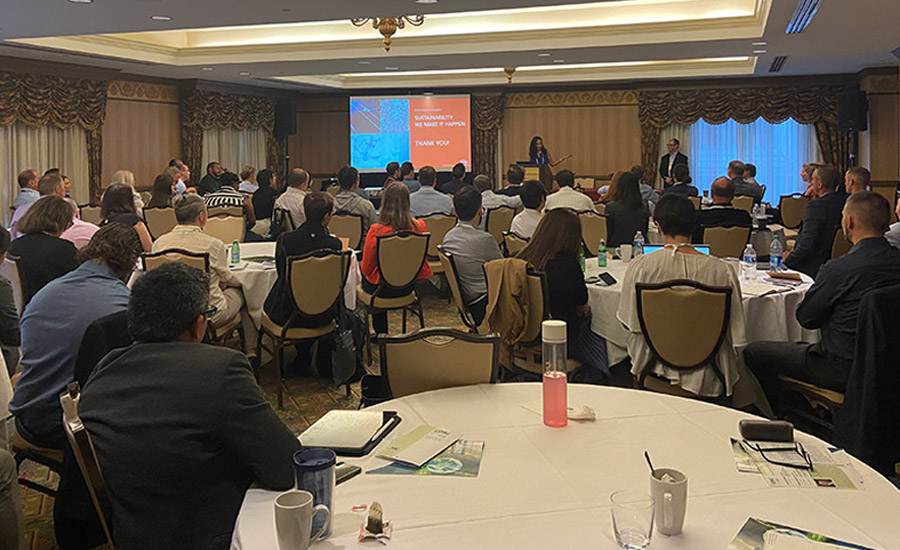First-Ever ASC Sustainability Forum Tackles Key Issues Facing Adhesives and Sealants Industry
Professionals in the adhesives and sealants industry met in September to discuss the trends, challenges, and opportunities created by the drive for sustainability.

Image courtesy of amato1987 via www.gettyimages.com
Everyone is talking about sustainability. It is on the minds of many CEOs, including leaders in the adhesive and sealant industry. In September, the Adhesive and Sealant Council (ASC) hosted its first Sustainability Forum in Pittsburgh. With sponsorships from Covestro, Arkema, and Kraton, the two-day forum gathered industry professionals to discuss pertinent topics including trends, challenges, opportunities, and market drivers within the framework of sustainability.
Chris Miller, senior global research director at Arkema Coating Resins, kicked off the forum with a keynote address, “Sustainable Development Trends and Outlook for the Adhesive and Sealant Industry.” In his address, Miller outlined the key drivers to more sustainable materials: substances of concern, alternative feedstocks, energy intensity, and sustainable performance attributes. Regarding alternative feedstocks, he used examples of how certain products from Arkema fit within the various approaches to bio-based and bio-attributed products. He outlined the elements considered when assessing energy intensity, such as energy within the process, building efficiency, and lightweighting. He then gave examples of areas for innovation that enhance sustainable performance attributes, such as longer service life, compostability, and recyclability. Finally, he gave his view of where the chemical industry is heading in the next five years in regards to sustainability.
One of the tools companies can utilize as they create and quantify their sustainability strategies is the Life Cycle Assessment (LCA). Tad Radzinski, the president of Sustainable Solutions Corp., gave an overview of LCA requirements in his presentation, “Sustainable Product Innovation for Adhesives and Sealants to Meet Market Demands.” Sustainable Solutions Corp. advises companies as they change their business operations through sustainability. At the beginning of his presentation. Radzinski pointed out that many employees, suppliers, and specifiers are of the younger generation, and they care about sustainability. He went on to explain that the events of the last year have reinforced the understanding that sustainability risks, particularly risks surrounding the climate, are also investment risks. Radzinski also shared an interesting pie chart of ASC member companies, which showed companies with in-depth sustainability reporting compared to those without full sustainability reporting, and companies with sustainability information and companies without this information.
Tim Thiel, Sustainability & Public Affairs North America, Covestro LLC, and Dr. Melissa Bilec, William Kepler Whiteford Professor in Civil & Environmental Engineering and co-director of the Mascaro Center for Sustainable Innovation at the University of Pittsburgh, discussed the launch of the Covestro Circular Economy Program at the university. This program is the first comprehensive academic, research, and innovation Ph.D. program in the United States with a focus and goal of designing for the circular economy. The program aims to create experts in circular economy principles leveraging Covestro’s successes in this area.

Photo courtesy of the Adhesive and Sealant Council.
Covestro’s sustainability efforts were highlighted again later that evening when the company welcomed forum attendees to a tour and networking reception/dinner at the company’s BrightSpace Center. The building and grounds of this facility is reported to meet the highest standards of sustainability and energy efficiency while also preserving the historic character of the building. On the National Register of Historic Places, the building is also a LEED Platinum designed structure, making it potentially the only LEED designed structure to also quality for Historic Tax Credits.
The next day, John Brandt, technical manager—adhesives and sealants North America Coatings and Adhesives at Covestro, talked about the need for collaboration between raw material suppliers, formulators, product designers, and end users to create products that are truly circular in nature. He offered several examples of this kind of cooperation, including Soft Landing, a mattress-recycling program in Australia supported by Covestro. The program is helping to address what was approximately 1.25 million mattresses that went into landfills in Australia every year. Soft Landing diverts the mattresses from landfills and recovers components to recycle. Covestro is helping to close the loop for polyurethane mattresses with a process for recovering both core raw materials and a new pilot plant for chemical recycling. With these cooperations within the value chain, companies can help to create a more circular economy.
Another conference highlight was a presentation by Gloriamar Gamez, senior sustainability manager North America at Henkel Adhesive Technologies. Gamez gave a very informative review on upcoming legislation and sustainability initiatives in the EU and the United States, and explained how these could potentially affect the industry. EU initiatives that she discussed included: the European Green Deal, which aims to make Europe climate-neutral by 2050; the EU Chemical Strategy for Sustainability, which, among other things, requires more (eco)toxicological data on chemicals, more hazard classes, more substance bans based on intrinsic hazards, and stricter safety assessment methodology for products; and The Classification, Labelling and Packaging, which will create more focus on circularity within the packaging/plastics industry. Gamez also outlined the main objective of the Sustainable Product Initiative (SPI), which includes making products greener through key performance requirements, prevents destruction of unsold goods, and sets mandatory requirements for green procurement. She provided a very useful timeline that outlined the implementation of these and other initiatives in the EU. In relation to the United States, Gamez explained the impacts that the Inflation Reduction Act and the CHIPS and Science Act will have on industry. She also discussed key state legislation regarding packaging, and the SEC’s response to climate and ESG risk assessments.
There were many other informative sessions covering topics such as lignin-based PU adhesives, technologies for developing sustainable hot-melt adhesives, trends in sustainability in the hygiene industry, the importance of sustainable packaging across the value chain, the newly formed Sustainability Program from the Adhesion Society, and sustainable solutions within chemical distribution. The most striking thing to me about the forum was the high level of commitment and enthusiasm that both presenters and attendees brought to addressing these issues. It is clear that sustainability is one of the biggest trends within the adhesive and sealant industry, as well as the broader chemical industry and beyond. It is also clear that to solve issues surrounding sustainability, it will take cooperation with all elements of our industry, from raw materials suppliers and formulators, through to end-users.
For more information about the Adhesive and Sealant Council and its programs, visit www.ascouncil.org.
Looking for a reprint of this article?
From high-res PDFs to custom plaques, order your copy today!








